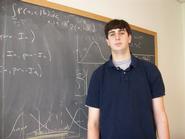
Will Eagan '11 presented a poster at the 215th meeting of the American Astronomical Society (AAS) in Washington, D.C., on Jan. 4. The annual meeting of the AAS is the main conference for professional astronomers in North America. Eagan's poster was titled "Comparison of Properties of High- and Low-Redshift Ultra-luminous Infrared Galaxies." It resulted from research he conducted last summer in collaboration with Assistant Professor of Physics Natalia Connolly and Dr. Brian Connolly, a postdoctoral researcher at the University of Pennsylvania and scholar-in-residence at Hamilton.
Ultra-luminous infrared galaxies (ULIRGs) are fascinating astronomical objects, emitting more than a trillion solar luminosities in the infrared part of the electromagnetic spectrum. They are almost always merging galaxies, although many details about their formation and evolution are still unclear.
Eagan's research built upon an innovative approach to low-redshift (or nearby) ULIRGs, recently suggested by Prof. Connolly and Dr. Connolly and collaborators. Their new method of understanding ULIRGs has to do with applying sophisticated statistical techniques to compare ULIRG spectra, as well as using network diagrams to visualize the resulting comparison. Will extended this work to high-redshift (or distant) ULIRGs.
Will Eagan is a graduate of Hingham (Mass.) High School.
Ultra-luminous infrared galaxies (ULIRGs) are fascinating astronomical objects, emitting more than a trillion solar luminosities in the infrared part of the electromagnetic spectrum. They are almost always merging galaxies, although many details about their formation and evolution are still unclear.
Eagan's research built upon an innovative approach to low-redshift (or nearby) ULIRGs, recently suggested by Prof. Connolly and Dr. Connolly and collaborators. Their new method of understanding ULIRGs has to do with applying sophisticated statistical techniques to compare ULIRG spectra, as well as using network diagrams to visualize the resulting comparison. Will extended this work to high-redshift (or distant) ULIRGs.
Will Eagan is a graduate of Hingham (Mass.) High School.
Posted January 7, 2010
